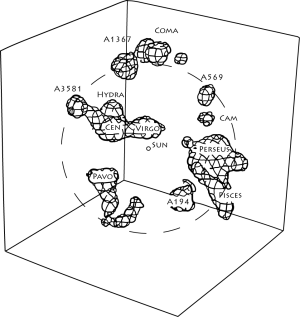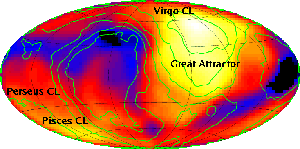 |
|
Fig. 1:
Mass concentrations in the Local Universe. Dashed circle denotes
~70 Mpc radius around the Sun (illustration is adapted from Hudson 1993,
MNRAS, 265, 43)
|
 |
 |
|
Fig. 2:
Space density of hard X-ray bright AGNs in different directions of the
sky.
|
|  |
We know from optical and infrared galaxy surveys that the distribution of
visible mass in the local Universe (within a few hundred Mpc from us)
is far from uniform. The number density of galaxies may vary by an
order of magnitude between galaxy superclusters and voids. The highest
known mass agglomerations
(M > 1015 Msun)
in the local Universe include the
nearby Virgo cluster and the more distant Great Attractor and Perseus-Pisces
supercluster.
It is now generally accepted that practically every galaxy in the local
Universe has a supermassive black hole in its center and some of
these black holes are active galactic nuclei (AGNs). It is therefore
natural to anticipate that the space density of AGNs should be
proportional to the space density of ordinary galaxies.
A recent hard X-ray survey of the whole sky performed by the
INTErnational Gamma-Ray Astrophysics Laboratory (INTEGRAL)
( Krivonos et al., 2007; astro-ph/0701836)
provided an unbiased census of
AGNs in the local Universe. Thanks to the hard X-ray selection, the
obtained sample includes many dust-enshrouded AGNs which are not visible at
optical and soft X-ray wavelegths. The effective depth of the survey allows
one to effectively probe the nearby Universe out to distances of order
100 Mpc.
Krivonos et al., 2007; astro-ph/0701836)
provided an unbiased census of
AGNs in the local Universe. Thanks to the hard X-ray selection, the
obtained sample includes many dust-enshrouded AGNs which are not visible at
optical and soft X-ray wavelegths. The effective depth of the survey allows
one to effectively probe the nearby Universe out to distances of order
100 Mpc.
Figure 2 demonstrates the space density of hard X-ray
bright AGNs in different directions of the sky. Each pixel in the
map represents the number density of sources within a cone of space
with a half-opening angle of 45 degrees. The image demonstrates that
the distribution of nearby AGNs is indeed strongly anisotropic, as
expected. For comparison, green contours show a usual tracer of mass
concentrations in the local Universe -- the surface density of IRAS
PSCz galaxies at distances smaller than 70 Mpc. The
large-scale feature in the north-east direction is consistent with the
projected position of the highest mass concentrations in the local
Universe -- the Virgo cluster and the Great Attractor. The
south-western structure is consistent with the Perseus-Pisces supercluster.
Krivonos R., Revnivtsev M., Sazonov S., Churazov E., Sunyaev R.
|

